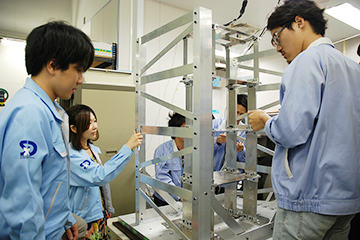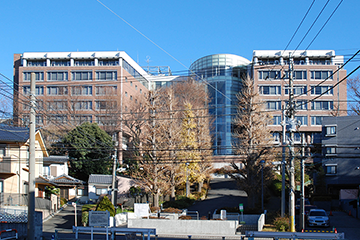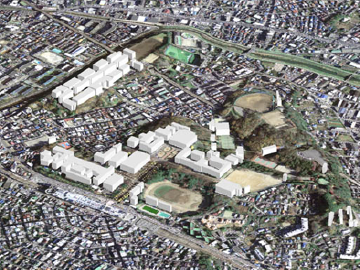
研究室では建築構造学,地震工学に関連した次の3つの研究テーマに取り組んでいます。
This laboratory focuses on the following three research themes.
建築物の構造設計技術の高度化Integrated Structural Design
設計者を支援する最適設計・最適制御の技術と,所有者・使用者が望む性能を具体化する性能設計の思想を融合した,新しい設計手法の開発に取り組んでいます。耐震,免震,制震(制振)といった構造システムの設計を高度化することで地震災害の一層の低減を目指しています。
We are developing an integrated structural design methodology that will synthesize performance-based design and optimal design of structures and control. This methodology will help realize architectural and civil engineering structures with the performance demanded by the users and owners. By improving the structural design by methods such as the effective use of passive, semi-active, and active vibration control systems, we aim to further mitigate the impact of earthquake disasters.

建物制震システムの震動台実験
A shaking table test of the vibration control system.
関連した最近の研究発表Related Recent Publications
- 木田祐輔,平岡笑暢,小檜山雅之:サーバ地震応答の故障閾値超過確率に基づくウォームスタンバイ, 地域安全学会論文集, No. 43, pp. 19-27, 2023.11
- Anamizu, R. and Kohiyama, M.: Study on a Simplified Model of a High-Rise Shear-Type Building for Evaluation of Q-Δ Resonance, Japan Architectural Review, Vol. 6, No. 1, e12406, 2023.10 (doi.org/10.1002.2475-8876.12406)
- 穴水亮輔,小檜山雅之:せん断型超高層建物のQ-Δ共振評価用簡易モデルに関する研究,日本建築学会構造系論文集, Vol. 88, No. 803, pp. 59-70, 2023.1 (https://doi.org/10.3130/aijs.88.59)
- Maki, S. and Kohiyama, M.: Torsional behavior of a non-eccentric structure considering the effect of shear deformations in vertical members, Japan Architectural Review, Vol. 5, No. 4, pp. 404-431, 2022.10 (doi.org/10.1002/2475-8876.12290)
- 穴水亮輔, 小檜山雅之:振動台実験および有限要素解析による高次モードを考慮したQ—Δ共振の基礎的検討, 構造工学論文集, 日本建築学会, Vol.68B, pp. 386-396, 2022.4 (doi.org/10.3130/aijjse.68B.0_386)
- Kohiyama, M., Yokoyama, H., and Maki, S.: Torsional response of a bisymmetric structure induced by bending–torsion interaction in vertical members, Japan Architectural Review, Vol. 5, No. 1, pp. 3-19, 2022.1 (doi.org/10.1002/2475-8876.12249)
- Mizutori, F. and Kohiyama, M.: Experiment of Torsional Response Induced by the Q–Delta Resonance, The Structural Design of Tall and Special Buildings, Vol. 30, No. 4, e1829, 21 pp., 2021.3 (doi.org/10.1002/tal.1829)
- 若林憲人,河西洋亮,小檜山雅之,江口僚,髙橋正樹:摩擦を考慮した動的解析結果の強化学習に基づくコンピュータビジョンを用いたキャスタ付き機器の地震応答制御, 構造工学論文集, Vol. 66B, pp. 305-314, 2020.3
- Masayuki Kohiyama, Masashi Omura, Masaki Takahashi, Osamu Yoshida, and Koichi Nakatsuka: Update of control parameters for semi-actively controlled base-isolated building to improve seismic performance, Japan Architectural Review, Vol. 2, No. 3, pp. 226-237, 2019.7 (doi: 10.1002/2475-8876.12090)
- Masayuki Kohiyama and Hiroki Yokoyama: Torsional Response Induced by Lateral Displacement and Inertial Force, Frontier in Built Environment, Vol. 4, Article 38, 12 pp., 2018.7 (doi: 10.3389/fbuil.2018.00038)
- Carmen Ho, Yunpeng Zhu, Zi-Qiang Lang, Stephen A. Billings, Masayuki Kohiyama, and Shizuka Wakayama: Nonlinear damping based semi-active building isolation system, Journal of Sound and Vibration, Vol. 424, pp. 302-317, 2018.6.
- 岡一也,小檜山雅之:強震動を受ける木造住宅の質量偏在と平面形状に起因した捩れ振動の動的解析による評価,構造工学論文集, Vol. 64B, pp. 479-492, 2018.3
地震被害の予測・推定Seismic Risk Assessment and Damage Estimation
地震防災は,事前の備えと事後の対応の2つのフェーズに分けることができます。適切な事前対策・事後対応を支援するため,地震動入力や構造物被害のより高精度の予測・推定手法の構築を目指しています。具体的には機械学習などの人工知能技術を用いた構造ヘルスモニタリングシステムの開発に取り組んでいます。
Earthquake disaster management comprises pre-event and post-event phases. We are developing high-precision methods of risk assessment and damage estimation to support appropriate pre-event tasks such as preparedness, mitigation, and early warning, and post-event tasks such as emergency response, recovery, and reconstruction. Specifically, we are working on the development of structural health monitoring systems using machine learning and other artificial intelligence techniques.

セミアクティブ免震建物の創想館の地震観測
A view of Sosokan, which has a semi-active-control base-isolation system; we are conducting the earthquake observation of Sosokan.
関連した最近の研究発表Related Recent Publications
- Takuzo Yamashita, Masayuki Kohiyama, and Kenta Watanabe: Deep neural network for detecting earthquake damage to brace members installed in a steel frame, Japan Architectural Review, Vol. 4, No. 1, pp. 56-64, 2021.1 (doi:10.1002/2475-8876.12188)
- Masayuki Kohiyama, Kazuya Oka, and Takuzo Yamashita: Detection method of unlearned pattern using support vector machine in damage classification based on deep neural network, Structural Control and Health Monitoring, Vol. 27, No. 8, e2552, 23 pp., 2020.8 (doi: 10.1002/stc.2552)
- 小檜山雅之,普天間基,岡一也,山下拓三:深層ニューラルネットワークを用いた損傷判別におけるk近傍法とウェルチのt検定に基づく未学習損傷パターンデータの検知, JCOSSAR2019論文集, pp. 319-326, CD-ROM, 2019.10
- Kohiyama, M.: Seismic Fragility Function for Ceilings: A Formulation Using Upper Floor Response Acceleration, Proc. 12th International Conference on Structural Safety and Reliability (August 6-10, 2017), Vienna, Austria, pp. 1873-1881, 2017.8
防災すまい・まちづくりResistant and Resilient Community Development
災害が生じにくく,災害が起きてもすばやく回復することができる「しなやかな仕組み」を備えた社会をデザインするため,リスク評価・被害推定技術を核にした,防災システムや防災すまい・まちづくりの研究に取り組んでいます。
Disaster reduction systems and disaster-resistant housing and communities are extensively studied to build a society with secure and resilient mechanisms against disasters; risk assessment and damage estimation of structures forms an important part of such studies.

建物から都市スケールの防災研究
Disaster reduction research over a wide range—from a building scale to an urban scale.
関連した最近の研究発表Related Recent Publications
- 小檜山雅之,高島帆風,山内壮泰,吉本充宏,久保智弘:次世代火山防災リーダーの育成を目的とした住民による自律的な対面・遠隔両形式の机上訓練を可能にするツールの開発, 地域安全学会論文集, No. 43, pp. 315-325, 2023.11
- 今野裕三,高島帆風,小檜山雅之,吉本充宏,久保智弘:火山災害対応における認知バイアスを克服するための訓練ツール, 地域安全学会論文集, No. 39, pp. 233-243, 2021.11
- 高島帆風,小檜山雅之,吉本充宏,久保智弘:次世代火山防災リーダーの育成を目的とした住民主体の災害机上訓練のフレームワーク, 地域安全学会論文集, No. 37, pp. 175-185, 2020.11
- 小檜山雅之,赤堀竜海,吉本充宏,久保智弘:拡張現実を用いた富士山火山ハザードマップ, 地域安全学会論文集, No. 37, pp. 147-155, 2020.11
- 河西洋亮,小檜山雅之:地区耐震化の検討を目的とした消火・延焼・避難の観点での街路網の評価,日本地震工学会論文集, Vol. 18, No. 2, pp. 35-50, 2018.5
- Dan, M. and Kohiyama, M.: Contribution of Corporate Social Responsibility to Post-Disaster Life Recovery of Employees, Journal of Disaster Research, Vol.12 No.4, pp. 811-821, 2017.8



